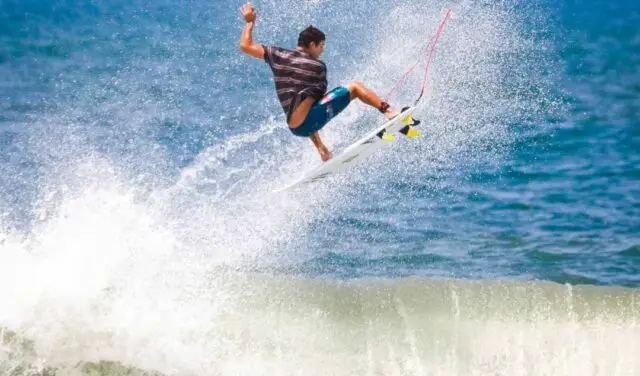Surfing is addictive, not only because of the feeling you get from sliding down a wave that is in motion and which disappears when you reach the shore, but also because of the contact with the sea that always makes you feel good: big or small waves.
One of the factors attributed to the recent popularity of surfing is its positive property for our health. It is scientifically proven that sliding on the waves improves our mood, the quality of our sleep, our concentration and is a strong ally against depression.
Surfing reduces adipose tissue (in women on the hips and men in the belly) and increases our aerobic capacity. It also improves aspects such as resistance, flexibility, coordination, balance and respiratory depth. Through the practice of surfing you will meet many other fans of this sport.
It teaches to be aware of responsibilities, for example, collaborating in collective tasks or to take care of the material, and to follow the rules, that is, not to interfere with other surfers or to know which waves can be surfed and which not.
Brief History of Surfing in Costa Rica
The history of surfing in Costa Rica tells that in 1952 the first two wave riders arrived at Ticobeaches, an American and a Hawaiian, ex-combatants of World War II, who adopted the sport from the native Hawaiians and had observed the its waves when flying warplanes from Pearl Harbor to Europe.

Surfing in Costa Rica began to be popular in the 1980s. The Caribbean and Boca Barranca became the most visited places, as had good communication routes. It was in “Boca Barranca” where the practice and inspiration of “building and sliding” started. Pioneer surfers enjoyed the waves in the first selection of the “mouth”, the famous “segunda”.
Brisa Hennessy, the Costa Rican star surfer who always smiles
The professional surfer, who grew up in the Costa Rican jungle, is known for always having a smile on her face. She represented Costa Rica at the 2020 Tokyo Olympics, where reaching the quarterfinals. The 22-year-old is currently second in the world ranking, but what makes the difference is her personality: genuine and open-hearted. This season, more than ever, she has learned how to combine the facet with the ferocity necessary to excel as a competitor on the World Surf League (WSL) Championship Tour (CT).
“I’ve been very lucky in my start to the year, and I think this has definitely come with a lot of work, a lot of dedication, a lot of tears and a lot of human emotions,” Hennessy explains.
Brief ABC of Surfing in Costa Rica
Where do you practice surfing in Costa Rica?
The top five surf destinations in Costa Rica are first and foremost Playa Hermosa, near the famous Jaco beach. In second place, Playa Pavones, in the Central and South Pacific.Third, Roca Bruja and around Playa Grande, both in Guanacaste and, finally, Salsa Brava in the Caribbean.
What is the best beach for surfing in Costa Rica?
Guanacaste: Located on the Pacific coast, Tamarindo stands as the most popular surf area. Due to its central location, the area offers easy access to Roca Bruja, Playa Langosta (a very close walk to the south) and Playa Negra, just to mention a few.
What is the best wave in Costa Rica?
Tamarindo offers consistent waves year-round and a long stretch of white sand. It is considered one of the best waves in Costa Rica. Location: Guanacaste.
How much does a surf lesson cost in Costa Rica?
The average price of a surf lesson is 9866₡, although it tends to vary greatly.
When is the best time to surf in Costa Rica?
In the part of the North Pacific or Guanacaste the best months are from December to April. If you go in the Spanish summer, the best option is to go to the Central and South Pacific, whose wave season runs from May to November.
As you can see, Costa Rica is a perfect surf destination, and not just because of its waves, but for all the good vibes that surround the “Pura Vida” way of life…so come and ride the “big one” in Costa Rica!

